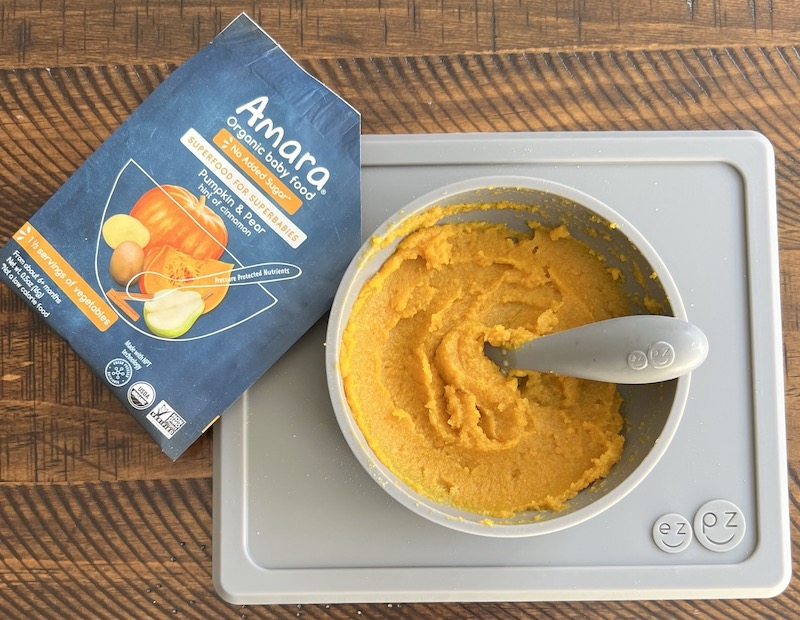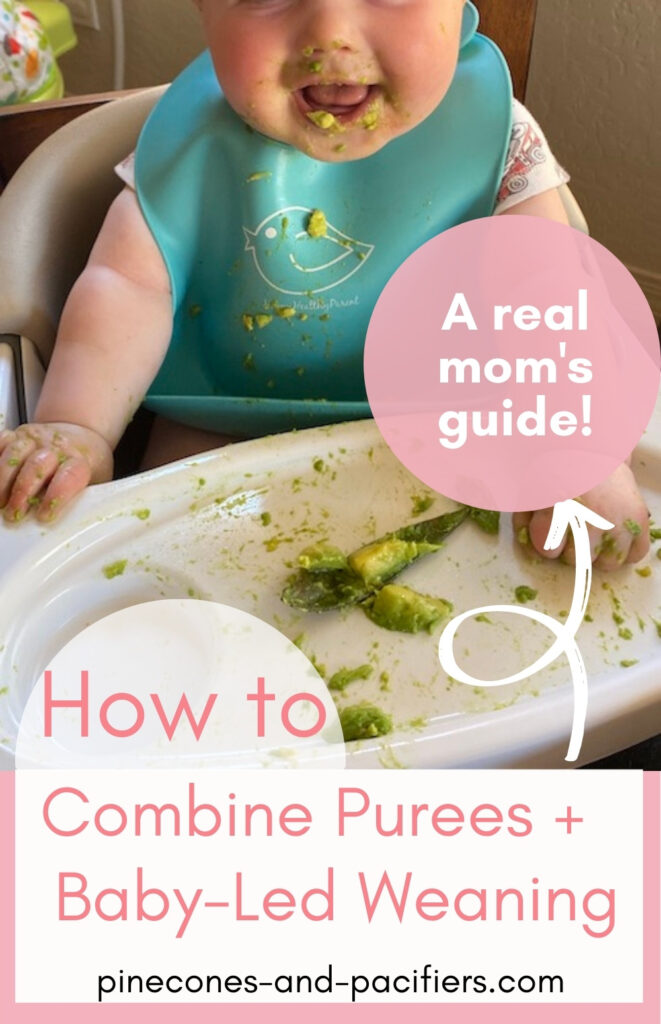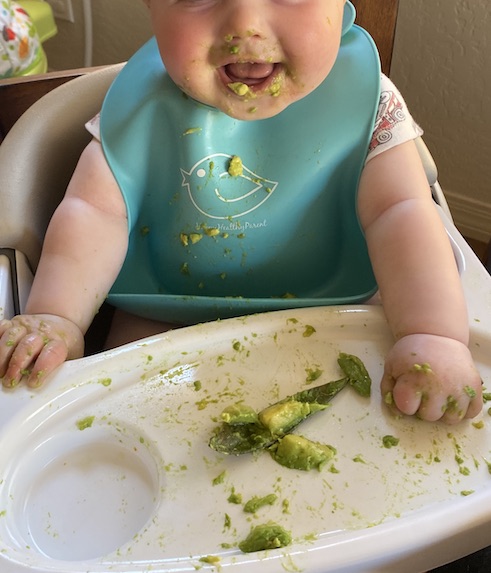Combo feeding approach combining purees and baby-led weaning. A real-life mom’s guide of how to introduce solids through combo feeding.
Our Combo Feeding Approach
*Please consult your pediatrician with help making the right decision for your baby and family. I am just a real-life mom sharing my experience.
Purees (traditional weaning) and baby-led weaning seem to be opposing terms these days, however they can be used to compliment each other when teaching your baby how to eat food and weaning them off liquid feedings.

What is traditional weaning? Traditional weaning is generally used to describe feeding your baby purees with a spoon or even small bits of solid food, but is generally led by the adult.
What is baby-led weaning? Baby-led weaning is a feeding approach where most parents skip feeding their babies purees with a spoon and go right into solid foods. Parent’s follow the baby’s lead in watching for queues given by the baby on when to start and avoiding spoon feeding or feeding the baby directly (instead letting the baby feed themselves).
When choosing a weaning approach for your baby, you don’t have to be exclusive to one feeding approach or the other! Many parents, such as myself, combine purees and baby-led weaning successfully and go on to raise happy, healthy, eaters.
Its important to note that there is no one-sized-fits all approach to feeding your baby. It’s also not something that needs to be strict with timing, serving size, or how you introduce foods to your baby. Do what works best for your baby and your family!
Your baby may be ahead or behind of the age ranges provided below, but just remember that food is just a compliment to breast milk or formula at this age and eating is all about exposure and practicing (your baby is LEARNING to eat!)
Remember to follow along with us on Instagram for more baby & toddler meal ideas!
Here i’m sharing my experience combining purees and baby-led weaning with my first son; my second son actually refused purees and we went straight into baby-led weaning at 6 months old. You can read more about that experience here:
Baby Feeding Gear
You don’t need any special gear to feed your baby, although it can surely help your baby feel more comfortable and keep messes to a minimum. Here are some of my favorites:
Silicone Bib: a wipeable bib is a must to keep your baby clean(ish). This bib is our favorite because its made of non-toxic silicone and its the softest one we’ve found! It lies flat and doesn’t get bent or bunched up so it helps keep your baby cleaner!
Ingenuity Baby Seat: This 2-in-1 seat is awesome because it serves as a baby seat with a tray and it also converts into a booster seat at the table (we did this around 14-18 months with my boys). It has no fabric (a MUST because it gets so dirty) and is super easy to clean.
Step 1: Stage 1 Purees
The first step in introducing your baby to food through traditional weaning is to start with stage 1 purees. Stage 1 generally means single-ingredient foods that are fairly thin in texture. You can buy these ate the store and they are often labeled ‘stage 1’ or you can make your own at home using your food processor or baby food maker (we like the Nuby Baby Food Maker)
To start, you will want to introduce your baby to one ingredient at a time to make sure they tolerate the food okay and there aren’t any food allergies. Be sure to discuss with your pediatrician if you have any concerns or if you have food allergies in your family.
Age: 4-6 months
Serving size (purees): 1-2 oz per serving (2-4 Tbsp)
Temperature: room temperature or slightly warmer
Frequency: 1-2 times per day, about 1 hr after liquid feedings
Food ideas:
- Single grain cereal: rice cereal, oatmeal
- Veggie purees: carrots, sweet potato, peas, green beans, butternut squash, avocado
- Fruit purees: pears, peaches, apples, prunes, bananas
We loved these Munchkin White Hot Safety Spoons when starting purees! They seemed to be just the right size for very young eaters and I loved that they would turn white when the puree was too hot.
Step 2: Stage 2 Purees & Soft Solid Foods
Once your baby has learned how to eat purees and has exposure to different fruits, veggies, and grains individually, you can move on to stage 2 (or mixed ingredient) purees that are slightly thicker texture.
We started stage 2 purees around 6-8 months old. This is also the age that its generally safe to start introducing solid foods and when many babies start baby-led weaning. For more information on baby-led weaning check out this related post: Baby-Led Weaning Food Ideas & 7 Month Old Baby-Led Weaning Meal Ideas
To start the process of adding in solid foods you can either add in solids before purees, after purees, or you can swap out some meals to be 100% solid food. I prefer to offer solid foods after purees so that my son isn’t ‘hangry’ and is more willing to try different foods since he is happy.
Age: 6-8 months
Serving size (purees): 2-4oz per serving (4-8 Tbsp)
Serving size (solids): small amounts of food cut into strips or ‘fry shape’
Temperature: most babies prefer slightly warm or room temperature, but cool is okay too
Frequency: 2-3 times per day, about 1 hr after liquid feedings
Food ideas:
- Amara Organic Baby Foods (Use PANDP15 for 15% off)
- Serenity Kids Baby Food (Use JESSICA15 for 15% off)
- Combinations of fruits and veggies mentioned above. Introduce each ingredient by itself first to check for allergies.
- Peanut butter
- Yogurt
- Avocado, banana, baked sweet potato strips, baked carrot strips, lightly toasted bread strips
- Scrambled eggs
At this stage, don’t be worried if your baby doesn’t eat much solid food… or any at all! Every time you serve your baby food its a chance for exposure, even if they just look at, touch, play with, or taste and spit out the food.
Step 3: Stage 3 Purees & Additional Solid Foods
Once your baby gets more confident with eating purees and solids, increase the variety and serving size of their meals. For us, this generally happened around 8-10 months old, but don’t worry if your baby is ahead or behind of this range. Follow your baby’s lead and remember that food i just a compliment to breastmilk and formula at this age.
Your baby can now eat stage 3 baby foods which are multiple ingredients including grains, yogurt, fruit, veggies, and sometimes meat with thicker texture than stage 2.
Continue to offer solids after purees or consider swapping out some meals to be exclusively solids if your baby is enjoying their solid food.
Age: 8-10 months
Serving Size (purees): 4 oz per serving (8 Tbsp)
Serving Size (solids): smaller pieces of soft foods as your baby develops their pincer grip, larger serving sizes
Frequency: 3 times per day, about 1 hr after liquid feedings.
Solid food ideas:
- Veggies: Butternut squash cubed, tomatoes, green beans, peas
- Fruit: watermelon, berries, grapes (quartered),
- Dairy: shredded cheese, string cheese
- Grains: dry cereal, whole grain bread, pasta
- Meat: ground or shredded meat
- Banana pancakes (see 3 ingredient recipe here!)
- Spaghetti/pasta (or spaghetti squash!)
- Mac ‘n Cheese
- Avocado toast
For more food ideas check out these related posts: 8 Month Old Baby Self-Feeding & 9 Month Old Self-Feeding Food Ideas
Step 4: Solid Food & Begin to Eliminate Purees
At this stage around 10-12 months old start to eliminate purees and encourage your baby to eat more and more solid food. Their food may start to look more and more like a toddler diet and you might start to add in snacks as you eliminate liquid feedings as your approach 1 year old (in general liquid feedings are no longer needed after 1, but some families may continue to offer bottles or breastfeed if you see fit).
Age: 10-12 months
Serving size (solids): follow your baby’s lead on how much they want to eat at each meal, you are teaching them to self-regulate and should let them eat until they are full and not pressure them to finish everything if they want to stop eating.
Frequency: 3 times per day around meal time, possibly 1-2 snacks per day as needed.
Solid food ideas:
- Meals including combinations of fruits, veggies, grain, and dairy.
- Quesadilla with veggies
- Deconstructed taco (ground or shredded meat, tomato, cheese, beans)
- Lasagna
- Grilled cheese & tomato
- Whole wheat waffles, french toast or pancakes
- Deconstructed sandwich
- Work towards a well-balanced diet. Prioritize veggies & fruits, healthy dairy & whole grains
- Avoid hard foods like raw veggies until baby has more teeth and closer to 3-4 years old.
Thanks for stopping by! You might also like these related posts:
- Amazon Toy Organization Finds for Kids
- Great Wolf Lodge Grand Mound: Snowland Celebration Experience
- Stocking Stuffer Gift Guide for Little Kids
- Top Holiday Toys My Kids Play With the Whole Season
- Cardboard Gingerbread House: Must-have Holiday Toy

